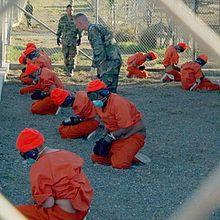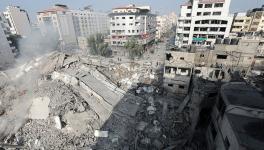Depressing and Infuriating: Looking Back at One of America's Greatest Disasters
"I always knew the Americans would bring electricity back to Baghdad. I just never thought they’d be shooting it up my ass." —Iraqi translator to Mark Danner, September 2003
Frustration defined the day of the American forces in Iraq during the last months of 2003. The White House and Defense Department said that there was no insurgency against the U.S. occupation. Kanan Makiya, a Brandeis University professor, had told the Bush administration that the Iraqis would greet the Americans with “sweets and flowers.” What the soldiers met instead, were bullets and improvised explosive devices. Former Ba’athists and Iraqi soldiers formed groups such as the Fedayeen Saddam—the army of Saddam—in an irregular assault on the U.S. troops. The immense technological advantage of the U.S. forces made a conventional battle impossible—guerrilla warfare was the only tactical way for the Iraqis to engage the U.S. forces.
The fog of the insurgency sat heavily on the U.S. commanders. They could not get to the heart of an insurgency that they underestimated and failed to understand. All this is now in the distant past. That atmosphere is hard to evoke. Statistics do not do justice to the moment. U.S. soldiers open fire into a crowd of civilians in Fallujah on April 28, 2003. In the cities of Iraq, U.S. troops begin to do night-raids, breaking into homes of Iraqis, terrifying everyone, seizing military age men and taking them off to be interrogated. Angry when insurgents used tree cover to fire on military convoys, the U.S. forces ripped old fruit trees (date, pomegranate, lime) to extend their security zone. Troops stomped into mosques with their shoes on, arresting sheikhs here and there (the most dramatic being the entry into Fallujah’s Grand Mosque to arrest Sheikh Jamal Shakur). Such was the mood in Iraq in the early years of the U.S. occupation. It was bitter and harsh.
Insurgencies are not broken by science. The U.S. media built up some generals as intellectuals of counter-insurgency—case in point being David Petraeus, the co-author of Field Manual 3-24 Counterinsurgency. This was propaganda. The real counter-insurgency in the field came between the random shootings and the “neighborhood sweeps,” the night-raids and the “enhanced interrogation” of the detainees. “Live our Values” and “Be a Good Guest” seemed perfectly reasonable ideas for Petraeus’ manual, but they had no bearing on the ground. More realistic was the assessment by the UK’s Brigadier Nigel Aylwin-Foster, who suggested that the “cultural insensitivity” of the U.S. forces “almost certainly inadvertent, arguably amounted to institutional racism.” Aylwin-Foster noted that the entire insurgency policy—“to kill or capture all terrorists and insurgents”—formed a carapace around thought. The U.S. commanders, he said, “saw military destruction of the enemy as a strategic goal in its own right,” with the U.S. military drawn to “swift and violent” combat operations.

Image Courtesy: en.wikipedia.org
Was it worthwhile? Was anything learned? Military intelligence officers told the International Committee of the Red Cross in 2006 that “between 70 percent and 90 percent of the persons deprived of their liberty in Iraq had been arrested by mistake.” The outcome of these mistakes is considerable for Iraqi society. America might have walked away, but Iraq is stuck with the consequences. One of them is the emergence of ISIS.
Iraqis spoke candidly in those early years after 2003 about the rough treatment their society had been subject to by the U.S. occupation. But the reports from Iraq did not penetrate the consciousness of the American liberals. It took the revelations of the pictures from Abu Ghraib prison to rattle that sensibility. The war—which many Americans opposed—now seemed not only illegal and unnecessary, but also deeply ugly. The pictures from Abu Ghraib, published in the New Yorker (2004), became the symbol of the Iraq War. This is the “bad war,” said State Senator Barack Obama. The “good war,” for him, was the U.S. campaign in Afghanistan.
It says a great deal about the limitations of U.S. liberalism that it could see the military campaign in Afghanistan as good. Much of what had begun to define the heartless U.S. practice in Iraq had been imported directly from Afghanistan. Night-raids, “enhanced interrogation,” firing into crowds—this grammar had been set in Afghanistan and imported wholesale to Iraq. Janis Karpinski, who ran the Abu Ghraib prison, said that the torture came from interrogators who had learned their trade in “Bosnia, Afghanistan and Gitmo.” Parwan Detention Facility mirrored Abu Ghraib—Alex Gibney’s Taxi to the Dark Side (2007) should have done what the 2004 New Yorker article had done, but it didn’t. Afghanistan had to remain the “good war.” The brutalities inflicted there, remained there. Something good had to come from the American wars.
Now, more evidence emerges of the ugly soul of this Global War on Terror. When the CIA picked up its “detainees,” it would strip them naked, photograph them and send them along to one of its “black sites,” to a third country to be tortured or to Guantanamo. There are at least fourteen thousand photographs of naked “detainees” that are held by the CIA. The U.S. Senate report on torture has a footnote, which reveals that the CIA has “photographs of detainees in the process of being transported.” The Guardian reveals that these photographs were taken of naked “detainees.” In 2005, the U.S. Justice Department deemed it acceptable to strip “detainees.” Its lawyers argued that the technique causes “psychological discomfort, particularly if a detainee, for cultural or other reasons, is especially modest.” Lisa Hajjar, author of Torture: A Sociology of Violence and Human Rights (2013), told me that this form of violence is part of the “disorientation, debility and dread” routine; it is, she says, a “shame multiplier.” These photographs are a testimony of depravity.
Ray McGovern, who was a CIA analyst, tells me, “This is sick stuff,” which his side of the building at Langley heard of only through the media. A CIA analyst who had been based in Afghanistan told me that he knew of such practices; he said that by the 2000s such behavior had become routine. None of this is unique to the Americans. Laleh Khalili, author of Time in the Shadows: Confinement in Counterinsurgencies (2013), tells me that nudity as a weapon of interrogation is used by the Israelis against the Palestinians and had been used by the British in Ireland. She agrees that this is “sick stuff,” as McGovern notes, but suggests a bureaucratic motive as well. Western states “are obsessed with biological and biometric data,” she says, and these photographs might have been taken and kept as part of a “record of detainee bodies.” Jinee Lokaneeta, author of Transnational Torture (2014), follows Susan Sontag here. She tells me that the photographs might have something to do with “holding on to some kind of mementos from lynchings and other such atrocities.” For the “detainee,” whether the pictures were taken as souvenirs or for biometric data is irrelevant. Their humanity was sought to be rendered.
Were these photographs and was the torture merely the operations of an out of control bureaucracy? In 2004, the CIA’s inspector general—John Helgerwon—wrote that these techniques “appear to constitute cruel and degrading treatment under the Geneva Conventions.” No one bothered with Helgerwon’s admonishments. This was not a moral problem. Torture in the cells and the torture of society were the political violence that the U.S. used to crush an insurgency that it could not tolerate. There were lessons here from the Israelis, whose Chief of Staff Moshe Ya’alon advised—in 2002—that his government’s actions were chemotherapy against the Palestinian cancer on the Israeli body politic. “There are all kinds of solutions to cancerous manifestations,” Ya’alon told Ha’aretz. “Some will say it is necessary to amputate organs. But at the moment I am applying chemotherapy.” The honest brutality of Ya’alon is absent in the bureaucratic language of the American military and CIA. Chemotherapy is not merely metaphorically used here. That the United States pummeled Falluja, for instance, with carcinogenic depleted uranium suggests that they took Ya’alon at his word. A study by Dr. Chris Busby, Malak Hamdan and Entesar Ariabi (Cancer, Infant Mortality and Birth Sex-Ratio in Fallujah Iraq, 2005-2009, 2010) finds a twelve-fold increase in childhood cancer in the period under study and a four-fold increase in all cancers. The metastization of the cancers happened faster in Fallujah than in Hiroshima and Nagasaki. Iraq suffers now and will suffer for a long time the devastation of these cancers and of the violations of its social life under the U.S. occupation.
I asked the CIA about these photographs, and more broadly about the “chemotherapy” that the U.S. had applied against Iraq. They did not wish to dignify my questions.
Vijay Prashad is professor of international studies at Trinity College in Hartford, Connecticut. He is the author of 18 books, including Arab Spring, Libyan Winter (AK Press, 2012), The Poorer Nations: A Possible History of the Global South (Verso, 2013) and the forthcoming The Death of a Nation and the Future of the Arab Revolution (University of California Press, 2016). His columns appear at AlterNet every Wednesday.
Disclaimer: The views expressed here are the author's personal views, and do not necessarily represent the views of Newsclick
Get the latest reports & analysis with people's perspective on Protests, movements & deep analytical videos, discussions of the current affairs in your Telegram app. Subscribe to NewsClick's Telegram channel & get Real-Time updates on stories, as they get published on our website.
























